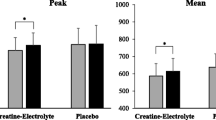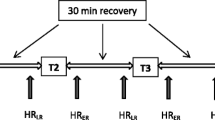Abstract
The main aim of this study was to investigate the influence of consuming a 6% carbohydrate-electrolyte (CHO-E) solution on the intermittent, high-intensity endurance performance and capacity of adolescent team games players. Fifteen participants (mean age 12.7 ± 0.8 years) performed two trials separated by 3–7 days. In each trial, they completed 60 min of exercise composed of four 15-min periods of part A of the Loughborough Intermittent Shuttle Test, followed by an intermittent run to exhaustion (part B). In a double-blind, randomised, counterbalanced fashion participants consumed either the 6% CHO-E solution or a non-carbohydrate (CHO) placebo (5 ml kg−1 BM) during the 5 min pre-trial and after each 15-min period of part A (2 ml kg−1 BM). Time to fatigue was increased by 24.4% during part B when CHO was ingested (5.1 ± 1.8 vs. 4.1 ± 1.6 min, P < 0.05), with distance covered in part B also significantly greater in the CHO trial (851 ± 365 vs. 694 ± 278 m, P < 0.05). No significant between-trials differences were observed for mean 15-m sprint time (P = 0.35), peak sprint time (P = 0.77), or heart rate (P = 0.08) during part A. These results demonstrate, for the first time, that ingestion of a CHO-E solution significantly improves the intermittent, high-intensity endurance running capacity of adolescent team games players during an exercise protocol designed to simulate the physiological demands of team games.





Similar content being viewed by others
References
Ali A, Williams C, Nicholas W et al (2007) The influence of carbohydrate-electrolyte ingestion on soccer skill performance. Med Sci Sports Exerc 39:1969–1976
Armstrong N (ed) (2007) Paediatric exercise physiology. Churchill Livingstone Elsevier, Philadelphia
Aucouturier J, Baker JS, Duché P (2008) Fat and carbohydrate metabolism during submaximal exercise in children. Sports Med 38:213–238
Backhouse SH, Ali A, Biddle SJH et al (2007) Carbohydrate ingestion during prolonged high-intensity intermittent exercise: impact on affect and perceived exertion. Scand J Med Sci Sports 17:605–610
Balsom PD, Seger JY, Sjodin B et al (1992) Physiological responses to maximal intensity intermittent exercise. Eur J Appl Physiol 65:144–149
Balsom PD, Wood K, Olsson P et al (1999) Carbohydrate intake and multiple sprint sports: with special reference to football (soccer). Int J Sports Med 20:48–52
Bangsbo J (1994) The physiology of soccer with special reference to intense intermittent exercise. Acta Physiol Scand Suppl 619:1–155
Boutron I, Estellat C, Ravaud P (2005) A review of blinding in randomised controlled trials found results inconsistent and questionable. J Clin Epidemiol 58:1220–1226
Cohen J (1992) A power primer. Psychol Bull 112:155–159
Davis JM, Welsh RS, Alderson NA (2000) Effects of carbohydrate and chromium ingestion during intermittent high-intensity exercise to fatigue. Int J Sport Nutr Exerc Metab 10:476–485
Edwards AM, Mann ME, Marfell-Jones MJ et al (2007) Influence of moderate dehydration on soccer performance: physiological responses to 45 min of outdoor match-play and the immediate subsequent performance of sport-specific and mental concentration tests. Br J Sports Med 41:385–391
Ekblom B (1986) Applied physiology of soccer. Sports Med 3:50–60
Foskett A, Williams C, Boobis L et al (2008) Carbohydrate availability and muscle energy metabolism during intermittent running. Med Sci Sports Exerc 40:96–103
Greenhaff PL, Nevill ME, Soderlund K et al (1994) The metabolic response of human type I and II muscle fibres during maximal treadmill sprinting. J Physiol 478:149–155
Karlberg J (2002) Secular trends in pubertal development. Horm Res 57:19–30
Lavcanska V, Taylor NF, Schache AG (2005) Familiarization to treadmill running in young unimpaired adults. Hum Mov Sci 24:544–557
Malina RM (2005) Youth football players: number of participants, growth and maturity status. In: Reilly T, Cabri J, Araújo D (eds) Science and football V. Routledge, New York
Marino FE, Lambert MI, Noakes TD (2004) Superior performance of African runners in warm humid but not in cool environmental conditions. J Appl Physiol 96:124–130
Maughan RJ, Leiper JB (1999) Limitations to fluid replacement during exercise. Can J Appl Physiol 24:173–187
Mirwald RL, Baxter-Jones ADG, Bailey DA et al (2002) An assessment of maturity from anthropometric measurements. Med Sci Sports Exerc 34:689–694
Morris JG, Nevill ME, Thompson D et al (2003) The influence of a 6.5% carbohydrate-electrolyte solution on performance of prolonged intermittent high-intensity running at 30°C. J Sports Sci 21:371–381
Nicholas CW, Williams C, Lakomy HKA et al (1995) Influence of ingesting a carbohydrate-electrolyte solution on endurance capacity during intermittent, high-intensity shuttle running. J Sports Sci 13:283–290
Nicholas CW, Tsintzas K, Boobis L et al (1999) Carbohydrate-electrolyte ingestion during intermittent high-intensity running. Med Sci Sports Exerc 31:1280–1286
Noakes TD, St Clair Gibson A, Lambert EV (2005) From catastrophe to complexity: a novel model of integrative central neural regulation of effort and fatigue during exercise in humans: summary and conclusions. Br J Sports Med 39:120–124
Olds T, Tomkinson G, Léger L et al (2006) Worldwide variation in the performance of children and adolescents: an analysis of 109 studies of the 20-m shuttle run test in 37 countries. J Sports Sci 24:1025–1038
Ratel S, Duche P, Hennegrave A et al (2002) Acid-base balance during repeated cycle sprints in boys and men. J Appl Physiol 92:479–485
Riddell MC, Bar-Or O, Wilk B et al (2001) Substrate utilization during exercise with glucose and glucose plus fructose ingestion in boys ages 10–14 yr. J Appl Physiol 90:903–911
Roemmich JN, Barkley JE, Epstein LH et al (2006) Validity of PCERT and OMNI walk/run ratings of perceived exertion. Med Sci Sports Exerc 38:1014–1019
Saltin B (1973) Metabolic fundamentals in exercise. Med Sci Sports Exerc 5:137–146
Sandercock G, Voss C, Gladwell V (2008) Twenty-metre shuttle run test performance of English children aged 11–15 years in 2007: comparisons with international standards. J Sports Sci 26:953–957
Spencer M, Bishop D, Dawson B et al (2006) Metabolism and performance in repeated cycle sprints: active versus passive recovery. Med Sci Sports Exerc 38:1492–1499
SportScotland (2008) Sports participation in Scotland 2007. SportScotland, Edinburgh
Taylor DJ, Kemp GJ, Thompson CH et al (1997) Ageing: effects on oxidative function of skeletal muscle in vivo. Mol Cell Biochem 174:321–324
Thevenet D, Tardieu-Berger M, Berthoin S et al (2007) Influence of recovery mode (passive vs. active) on time spent at maximal oxygen uptake during an intermittent session in young and endurance-trained athletes. Eur J Appl Physiol 99:133–142
Timmons BW, Bar-Or O, Riddell MC (2003) Oxidation rate of exogenous carbohydrate during exercise is higher in boys than in men. J Appl Physiol 94:278–284
Timmons BW, Bar-Or O, Riddell MC (2007) Influence of age and pubertal status on substrate utilization during exercise with and without carbohydrate intake in healthy boys. Appl Physiol Nutr Metab 32:416–425
Utter AC, Kang J, Nieman DC et al (2007) Carbohydrate attenuates perceived exertion during intermittent exercise and recovery. Med Sci Sports Exerc 39:880–885
van Nieuwenhoven MA, Brouns F, Kovacs EMR (2005) The effect of two sports drinks and water on GI complaints and performance during an 18-km run. Int J Sports Med 26:281–285
Welsh RS, Davis JM, Burke JR et al (2002) Carbohydrates and physical/mental performance during intermittent exercise to fatigue. Med Sci Sports Exerc 34:723–731
Zafeiridis A, Dalamitros A, Dipla K et al (2005) Recovery during high-intensity intermittent anaerobic exercise in boys, teens, and men. Med Sci Sports Exerc 37:505–512
Acknowledgments
The authors gratefully acknowledge the support of High5 Ltd, Bardon, Leicestershire, UK, for the supply of maltodextrin, electrolyte tablets, and drink bottles to enable completion of this study. The authors confirm that the conduct of this study complied fully with current Scottish law, and with the full ethical approval of the University of Edinburgh, Moray House School of Education ethics committee.
Conflict of interest statement
The authors declare they have no conflict of interest regarding this study.
Author information
Authors and Affiliations
Corresponding author
Additional information
Communicated by Jacques Poortmans.
Rights and permissions
About this article
Cite this article
Phillips, S.M., Turner, A.P., Gray, S. et al. Ingesting a 6% carbohydrate-electrolyte solution improves endurance capacity, but not sprint performance, during intermittent, high-intensity shuttle running in adolescent team games players aged 12–14 years. Eur J Appl Physiol 109, 811–821 (2010). https://doi.org/10.1007/s00421-010-1404-z
Accepted:
Published:
Issue Date:
DOI: https://doi.org/10.1007/s00421-010-1404-z




